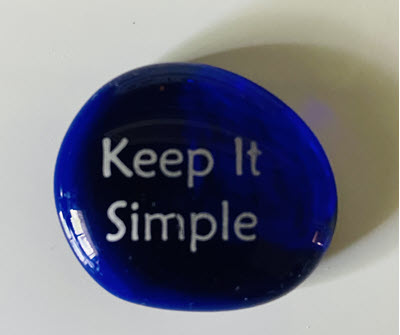 Keeping business writing simple sounds like a good idea. Your reader would certainly appreciate it.
Keeping business writing simple sounds like a good idea. Your reader would certainly appreciate it.
But imagine creating content for a boss who loves technical white papers with loads of references. Or you work in information technology and market to non-techie clients.
How do you keep your business writing simple when it’s not?
Visualize your writing.
Simple Business Writing Visualized
The visualization technique is a long-time practice used by writers.
- Entrepreneurs also use it to picture the journey of their business in reaching their destination goal.
- But you don’t have to be a professional writer to use visualization for simple business writing.
Any human can do it. Really. Let’s charge up those creative visions.
Visualize This
My love of simple thinks in threes – a beginning, middle, end. The illustration below shares three questions to ask yourself about the topic or subject of your business writing.
Now, let’s examine the three questions and look at an example. Follow along with the video. Margo deals with the fallout from an all too familiar challenge – COVID-19.
Visualization Technique Examples
One of my favorite bloggers, Henneke Duistermaat, puts her visual thinking into cartoons. In fact, she wrote a great post about this topic.
Even if you don’t have Henneke’s drawing ability, you can visualize your business writing. Let’s try it with Margo’s challenge.
Margo had several dogs as pets. She became adept at training and works part-time helping others learn how to train their dogs. In thinking about the new company software, Margo visualized the steps she takes in dog training.
The first step Margo took was thoroughly training on the new software so she knew it inside and out. Next, she thought about the best way to train her staff. She decided she needed the following critical elements.
- Make training interactive – it was the best way dog owners learned and Margo knew it helped simplify what trainees thought was a complex subject.
- Incorporate fun elements – her staff were young, competitive, and loved video games. Margo decided to use gamification in her training.
- Include incentives – Margo customized the incentives to each staff member and offered the incentives upon completion of the training.
When Margo prepared her script for training, one phrase popped into her head.
Keep it simple.
She visualized the steps in her dog training.
- Cues – like dog training’s simple, “Sit,” “Down,” “Drop it,” Margo designed simple cues for software training by using buttons with simple commands, like, “Click here,” or “Next”.
- Action – The gamification method provided clues for obtaining the correct response. It took users back if they missed a step to discover new clues for a successful finish.
- Reward – Throughout the training, audio and visual rewards signaled success. Users racked up points until reaching their ultimate reward for completing the course.
Simple Rewards
By visualizing your business writing, you simplified the task for yourself. And that translates to simple reading for your audience.
- Picture your point (or problem)
- Put yourself in the shoes of your reader
- Deliver what your reader needs
Simple rewards come from simple business writing. What tips do you have for keeping it simple – even when your topic is not that simple? Share your thoughts in Comments.
Note: This April 30, 2021 post is an update to the original post that published on July 25, 2013.
=====================
Helping you Keep it simple, clear & uniquely yours
=====================



I like the visualization technique, Cathy! I’ll have to try it.
My system is to list the key points I want to make, then put them in a logical order. (Shhh…don’t call it an outline. I hate outlines. But I love lists.) They great thing about your technique is the logical order becomes a story – complete with a conflict.
Thanks, Paula. I wrote a post once about how I love outlines. I was shocked how many writers are so passionate about hating outlines. LOL! 😀 Don’t worry, I won’t call this exercise an outline).
I do love stories. We all need a little drama in our life. 😉
Thanks for sharing your out -oops – list idea, Paula.
I tend to be auditory rather than visual, but I’m working with a videographer and learning to think more in pix… this will help.
That sounds like fun, Anne. You’ll have to let us know what you’re working on and how it’s going.
Thanks for the linkage, Cathy. Glad to inspire something other than headache. 😉
This is a brilliantly simple way to get to the point. I love it. I’ve not visualized Mary yet, but it sounds like a great way to bring the copy the relevance it needs.
You are most welcome, Lori. Thanks for the inspiration. 😉 Mary appreciates the attention. 🙂
Loved the video (more than the charts), but the verbiage was spot on.
Well, I guess one out of two isn’t bad. 😂